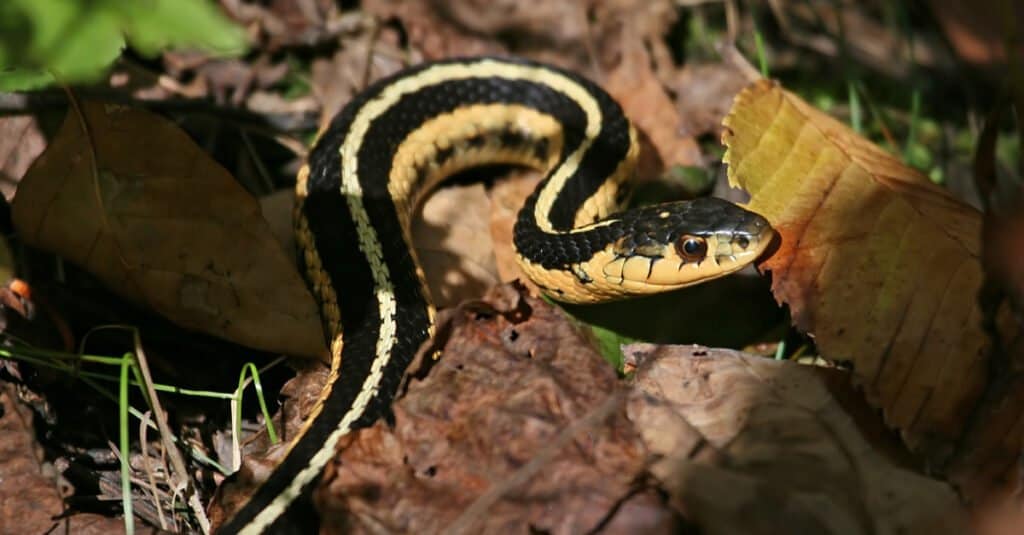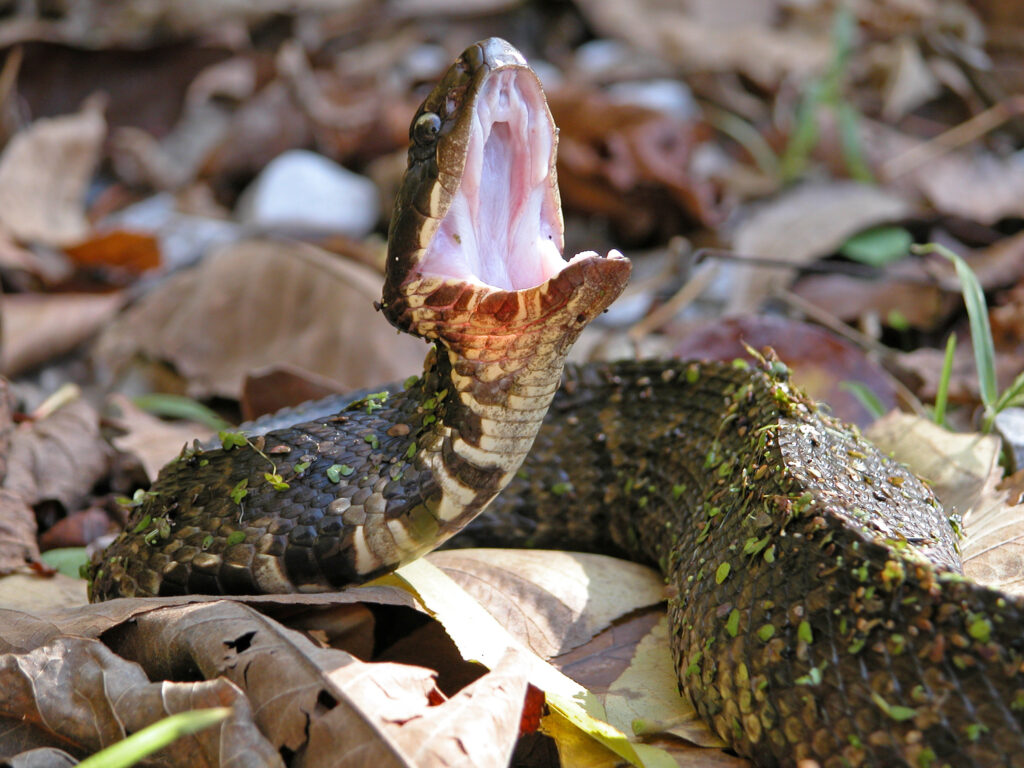Key Points:
- Garter snakes come in all shapes and sizes, varying throughout the 35 species.
- Generally harmless, these snakes are usually mid-sized (22-30 inches) and non-venomous.
- At 4.4 feet long, the largest garter snake recorded was stunningly bigger than average.
There are more than 35 known species of garter snakes. This list includes the more popular eastern garter snake, which is Virginia’s official snake, the black western ribbon snake, and the San Francisco garter snake, which is known as one of the snakes with the most beautiful patterns.
Generally, garter snakes are mainly beautiful and harmless, although not venom-free. They are usually medium-sized snakes and measure between 22 and 30 inches. In rare cases, garter snakes grow much longer than this. This article takes a look at garter snakes’ range, diet, behavior and more, and reveals the largest garter snake ever recorded.

Where Are Garter Snakes Found in America?
Garter snakes like to stay near water. They are found mostly in North America and are scattered all around in various areas and habitats. Garter snakes can be found in fields, lawns, forests, and grasslands that aren’t located far away from streams, ponds, or wetlands.
Are Garter Snakes Venomous?

Garter snakes are venomous but their venom isn’t strong enough to harm humans.
©John Czenke/Shutterstock.com
Initially, it was believed that garter snakes were nonvenomous snakes. However, in 2005, Bryan Fry, a biologist from the University of Melbourne discovered that this was wrong. According to the New York Times, Fry explained that the misconception was based on the fact that garter snakes do not have or need a lot of venom: “All they need to do is stun a frog or slow it down a bit, and it’s enough to help them.” Garter snakes are venomous but their venom isn’t strong enough to harm humans and mostly helps them kill their prey.
What Do Garter Snakes Eat?
Garter snakes are carnivorous. Due to their choice of habitat, garter snakes feed on a lot of amphibians and most smaller reptiles. If you have a pet garter snake, you can feed them thawed frozen rodents. They also snack on earthworms, frogs, and toads occasionally.
It is important to note that they do not eat a lot. When young, they eat every other day. Baby garter snakes feed on nightcrawlers, guppies, and earthworms. They do not receive maternal tending. They also eat plain tilapia or chicken cut up in small pieces.
However, adult garter snakes that feed mainly on rodents and/or amphibians eat once a week on average. It is possible to overfeed a snake, so be sure to consult your vet for the best meal plans for your pet garter snake.
Will a Garter Snake Bite You?
Garter snakes have fangs. They have opisthoglyphous fangs, which means that they have enlarged teeth in the back of their mouth and must actually chew on their prey to get the poison in. A garter snake can bite you but they are not likely to. However, a garter snake can and will bite you if it feels the need to protect itself. They are not aggressive and shouldn’t be feared.
How Do Garter Snakes Defend Themselves?
Garter snakes are not constrictors. Instead, they defend themselves with their venom and musk. Snake musk is foul-smelling and hard to get rid of. Sometimes, garter snakes mix their musk with feces to make it smell even worse.
Garter Snakes vs. Garden Snakes
Garter snakes are often called garden snakes. However, garter snakes are just one type — albeit the most popular — of “garden snakes,” snakes often found in gardens.
Some other nonvenomous or mildly venomous snakes are also called garden snakes. Species falling into this category include:
- Water snakes
- Racers
- Rat snakes
- Corn snakes.
Harmless snakes such as these can be greatly beneficial to your garden and yard, providing a natural way to control pest populations to keep you and your plants safe.
Do Garter Snakes Make Good Pets?
Due to their calm and non-aggressive natures, garter snakes make good pets. However, if you decide on a garter snake for a pet, do not attempt to catch one in the wild. It will do anything to escape. While its poison might not be deadly, it can also musk you. Instead, visit your local pet store.
Fun Facts About Garter Snakes
- Unique patterns: Garter snakes are known for their lovely patterns. They have various colors and patterns depending on where they come from. Garter snakes only have vertical stripes. They have no longitudinal stripes and could be blue, gold, cream, or yellow.
- Great swimmers, poor climbers: Garter snakes never live too far from water. This is probably why they are great swimmers but not very good at climbing trees.
- Shy and docile: Garter snakes are rather afraid of humans and are likely to hide to avoid being seen. They are docile and calm snakes. Usually, garter snakes in captivity do not mind being picked and handled.
- Active: Garter snakes, unlike many other snake species, are very active during both day and night.
- Birth 20-40 babies at a time: Garter snakes do not lay eggs. After about two to three months, the pregnant mother gives birth to her babies alive. Garter snakes have 20-40 babies at a time!
What Is the Smallest Species of Garter Snake?

The smallest garter snake species is the short-headed garter snake.
©Eric Dale/Shutterstock.com
The short-headed garter snake is the smallest species of garter snake. They usually measure between 10 and 22 inches (0.8-1.8 feet) and feed only on earthworms. Short-headed garter snakes are mostly found in the northeastern parts of America.
What Is the Largest Garter Snake Ever Recorded?

The largest garter snake ever recorded was a red-sided garter that measured 52.8 inches.
©Matt Jeppson/Shutterstock.com
According to an article published by CBC NEWS on May 19, 2006, the discovery was made by Jonathan Wiens, then a master of science student at the University of Manitoba. Weins discovered a red-sided garter that measured 52.8 inches (4.4 feet), which made it the largest garter snake ever recorded.
According to his reports, the female snake was found in one of his traps while Weins was studying a snake den near Manitoba Hydro’s Jenpeg generating station at the north end of Lake Winnipeg. The snake was approximated to be about 12 years old. This was amazing considering that garter snakes usually live to a maximum of 4 to 5 years in the wild.
CBC reports that Weins let the snake go after marking her. “I don’t really get too attached to them,” he said. “I held it for a couple of days to make sure that it was indeed a record, to make sure I had everything recorded properly, but she’s just [number] 163. I hope to see her again in the fall. I’m hoping she’ll put on even more size and then I can recapture her and learn exactly how fast these things can grow.”
Other Record-Breaking Snakes

The largest cottonmouth snake ever recorded measured 74 inches long.
©iStock.com/Gerald DeBoer
Cottonmouth snakes are a venomous species of snake that are commonly found in the southeastern United States. They get their name from the white coloration inside their mouths, which they display when threatened or agitated. Cottonmouths, also known as water moccasins, prefer to live near bodies of water such as swamps and marshes.
The largest cottonmouth snake ever recorded was an impressive 74 inches long! This record-breaking specimen was found in Alabama in 1945 and weighed over 11 pounds. It is worth noting that cottonmouths usually only reach around 4 feet long when they are fully grown.
The diet of a cottonmouth snake can vary depending on factors such as its location and age. They are known to consume small mammals, birds, fish, amphibians, and reptiles. This flexibility in food choices could arguably contribute to their success as a species.
Cottonmouths have a reputation for being aggressive towards humans but typically only attack if they feel threatened or cornered. It’s important to keep your distance from these snakes and avoid provoking them in any way.
The photo featured at the top of this post is ©
Discover the "Monster" Snake 5X Bigger than an Anaconda
Every day A-Z Animals sends out some of the most incredible facts in the world from our free newsletter. Want to discover the 10 most beautiful snakes in the world, a "snake island" where you're never more than 3 feet from danger, or a "monster" snake 5X larger than an anaconda? Then sign up right now and you'll start receiving our daily newsletter absolutely free.
Thank you for reading! Have some feedback for us? Contact the AZ Animals editorial team.






